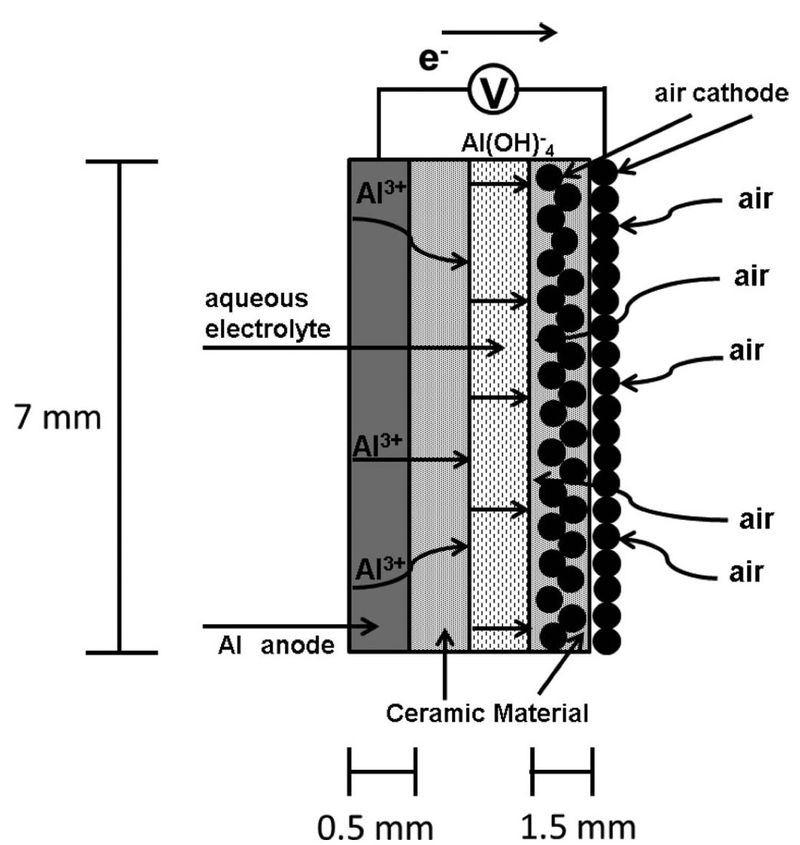chucho
1 kW
Anyone has more info on this batteries?
http://www.greencarcongress.com/2015/01/20150109-fuji.html

"Fuji Pigment Co. Ltd. has developed a new type of aluminum-air battery which can be recharged by refilling with salt or fresh water and which uses a modified structure to ensure longer battery lifetime. The company said it is constantly improving the battery performance and plans to commercialize the technology in the market by spring 2015. The technology, developed by Dr. Ryohei Mori, has been described in several papers over the past few few years, the most recent being an open access paper in the Journal of the Electrochemical Society.
Metal-air batteries use a catalytic air cathode in combination with an electrolyte and metal anode such as lithium, aluminum, magnesium or zinc. With very high theoretical energy densities, metal air technology is considered a promising technology candidate for “beyond Li-ion” next-generation batteries enabling future long-range battery-electric vehicles—assuming the development obstacles can be overcome.
Aluminum is an abundant, attractive anode material for energy storage and conversion because of its high specific capacity and highly negative standard electrode potential. In addition, aluminum is the most recycled metal in the world and is economically cheap. Highlighting this potential, Alcoa and Israel-based Phinergy in February 2014 entered into a joint development agreement to develop further Phinergy’s aluminum-air batteries. (Earlier post.)
Aluminum-air batteries the systems offer a theoretical specific energy of 8.1 kWh/kg (with respect to aluminum)—second only to the Li-air battery (13.0 kWh/kg).
However, aluminum-air technology suffers from parasitic hydrogen evolution caused by anode corrosion during discharge; this has been a long-standing barrier to the commercialization of aluminum–air batteries. Not only does it cause additional consumption of the anode material, but it also increases ohmic loss in the cell.
Parasitic corrosion has been shown to be suppressed by doping with high-purity aluminum (99.999% grade) and other alloying elements as well as by introducing corrosion inhibitors into the electrolyte. However, Dr. Mori noted in his JECS paper, these approaches have been largely unsuccessful in the commercial production of aluminum–air batteries, as by-products such as Al2O3 and Al(OH)3 accumulate at the anode and cathode, hindering further battery reaction.
To address this, Dr. Mori modified the aluminum-air battery structure by placing ceramic and carbonaceous materials between aqueous electrolyte and electrodes as an internal layer. This modified structure suppresses anode corrosion and byproduct accumulation, resulting in longer battery lifetime.
Basic properties of the battery as now announced by Fuji Pigment: 0.7-0.8 V; 400-800 mA/cell (10 cm x 10 cm); 4-8 mA/cm2. The battery works for a minimum of 14 days by refilling with water occasionally. Fuji Pigment says it modify the battery at the request of customers—for example: 10.0-12.0 V, 4.0-8.0 A, or more."
http://www.greencarcongress.com/2015/01/20150109-fuji.html
"Fuji Pigment Co. Ltd. has developed a new type of aluminum-air battery which can be recharged by refilling with salt or fresh water and which uses a modified structure to ensure longer battery lifetime. The company said it is constantly improving the battery performance and plans to commercialize the technology in the market by spring 2015. The technology, developed by Dr. Ryohei Mori, has been described in several papers over the past few few years, the most recent being an open access paper in the Journal of the Electrochemical Society.
Metal-air batteries use a catalytic air cathode in combination with an electrolyte and metal anode such as lithium, aluminum, magnesium or zinc. With very high theoretical energy densities, metal air technology is considered a promising technology candidate for “beyond Li-ion” next-generation batteries enabling future long-range battery-electric vehicles—assuming the development obstacles can be overcome.
Aluminum is an abundant, attractive anode material for energy storage and conversion because of its high specific capacity and highly negative standard electrode potential. In addition, aluminum is the most recycled metal in the world and is economically cheap. Highlighting this potential, Alcoa and Israel-based Phinergy in February 2014 entered into a joint development agreement to develop further Phinergy’s aluminum-air batteries. (Earlier post.)
Aluminum-air batteries the systems offer a theoretical specific energy of 8.1 kWh/kg (with respect to aluminum)—second only to the Li-air battery (13.0 kWh/kg).
However, aluminum-air technology suffers from parasitic hydrogen evolution caused by anode corrosion during discharge; this has been a long-standing barrier to the commercialization of aluminum–air batteries. Not only does it cause additional consumption of the anode material, but it also increases ohmic loss in the cell.
Parasitic corrosion has been shown to be suppressed by doping with high-purity aluminum (99.999% grade) and other alloying elements as well as by introducing corrosion inhibitors into the electrolyte. However, Dr. Mori noted in his JECS paper, these approaches have been largely unsuccessful in the commercial production of aluminum–air batteries, as by-products such as Al2O3 and Al(OH)3 accumulate at the anode and cathode, hindering further battery reaction.
To address this, Dr. Mori modified the aluminum-air battery structure by placing ceramic and carbonaceous materials between aqueous electrolyte and electrodes as an internal layer. This modified structure suppresses anode corrosion and byproduct accumulation, resulting in longer battery lifetime.
Basic properties of the battery as now announced by Fuji Pigment: 0.7-0.8 V; 400-800 mA/cell (10 cm x 10 cm); 4-8 mA/cm2. The battery works for a minimum of 14 days by refilling with water occasionally. Fuji Pigment says it modify the battery at the request of customers—for example: 10.0-12.0 V, 4.0-8.0 A, or more."

